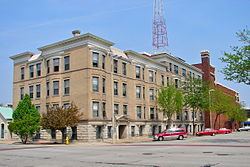Built 1903, 1913 Added to NRHP 21 August 2003 | NRHP Reference # 03000782 | |
 | ||
Similar Robert Wagner House, Peoples National Bank Buil, Rock Island Lines Pas, Connor House, Stauduhar House | ||
Sala Apartment Building is an historic building located in Rock Island, Illinois, United States. It was listed on the National Register of Historic Places in 2003.
Contents
History
The building was built in two sections. The southern section was built in 1903, and the northern section was built 10 years later. It is one of the earliest multiple family dwellings in the city of Rock Island. Both sections were built by Dr. St. Elmo Morgan Sala. He was from a family of physicians and graduated from Keokuk Medical College in 1882 and started his practice in Rock Island. Before building the apartment building the Salas lived in a home on 19th Street. The building was built south of their house. When the first section was completed they moved into apartment 101 and his office moved into the commercial space below. Dr. Sala died in 1921 and his wife, Mary Elizabeth, inherited the property. She married Judge Robert W. Olmsted and after she died, Judge Olmsted purchased the building from her estate in 1936. It was later inherited by his daughters.
Architecture
Rock Island architect Leonard Drack designed the southern section of the apartment building and C.D. McLane designed the northern section. The building consists of 25 apartments that are arranged around five interior light wells. It was built on top of a raised basement, which contained three commercial spaces, three apartments and storage. The foundations are built of six-course ashlar limestone, and the upper stories are covered in beige pressed brick. Three entrances in the Classical style, and placed symmetrically in the building, feature stone corner pilasters, a narrow Roman Ionic capital with an egg-and-dart detail and a stone entablature with the name “Sala.”
The apartments feature their original oak and pine woodwork, fireplaces, radiators, porcelain bathroom fixtures and some original light fixtures. The American Craftsman style is found in the north section. It is found in most of the dining rooms, which feature vertical panel wainscoting strips and high plate rails. The stair rails and fireplaces also reflect the simplicity of the style.
